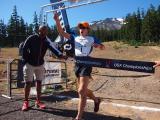It’s amazing how some days just work out. But in reality you can look back at all the things that went into the day to make everything work out the way they did, so in a way, nothing ever just works out. It’s how well you know your self and how thoughtful your preparation is toward that day. Now, I’m not saying that I had all of this planned out and knew exactly how the UROC race was going to go. I was by no means confident in my ability to get through 62.2 miles (or 63.5 as it turned out) because I was scared out of my mind, had never run that far before, and recent attempts at much shorter distances have turned out much worse.

This is getting to be a familiar position for me.
However, what I feel like I did do well was change what didn’t work in the past and use my brain the best I could to effect a different outcome. From my perspective, Ultrarunning is still in its infancy in terms of what we know about how to train. More and more information is put out there each year by guys that have experimented on themselves and have experienced both success and defeat. The sport of ultra running will be defined by who is willing to change their training to maximize their performances. To further the sport along, it is the defeats and blow ups that are often most helpful but the successes do have some value too, until a time in the future that the successful methods are pushed beyond their limits and they too become a defeat. Looking in the past at more competitive running events like the 5k, 10k or marathon, we’re living in about 1960 or so. There have been some major breakthroughs to the sport in Roger Bannister’s four minute mile, marathons that have gone sub 2:12, and legendary coaches such as Percy Cerutty, Arthur Lydiard, and Bill Bowerman are just starting to see there methods become more concrete coaching philosophy. All of these events are what helped push training theory forward to the basic training structure that all middle distance athletes train by. The bar that these pioneers raised their respective events to has since been eclipsed through slight tweaks to their methods but the general guidelines that they defined haven’t changed. Science has helped, but in most cases, science only serves to confirm what coaches have figured out through real world experimentation.

Ellie!!
So, ultrarunning is at this stage where athletes like Scott Jurek and Jeff Browning and coaches like Ian Torrence and Matt Fitzgerald have laid the foundation of what the general training guidelines need to look like but there is still a long way to go before we reach the performance plateaus that shorter distance events have experienced the past decade or so. But, then there are people like Ellie (awesome run at UROC) and Sage Canaday who have come out of the gate with impressive performances and consistently impressive results.

Sage, eating...again.
There’s a lot more to ultrarunning as well. Ultrarunning may be on a much slower learning curve based on the amount of knowledge that will be required by an athlete in a few years. A more intimate knowledge of the athletes body and the ability to tune in to special needs is a must in an ultra race much like it is in a marathon but even to a higher level due to the duration of a race. Right now, it feels like the sport is in a transition with respect to training theory.
Nutritional knowledge will become more important than ever before, and to a very individualized level. We haven’t yet reached a point where ultrarunning has any kind general training platform. Athletes will continue to experiment with different methods and a maybe a few will show promise.
Look at the 10k or marathon even: we run over distance in training, we run intensity workouts that are near or at the distance of the even. No one has ever attempted doing 100 mile or even 50 mile training runs regularly in training for these distances, but looking at the progression of ultrarunners there is clearly a benefit to running these distances as the body continues to get stronger and adapts to the training load that results from these extreme distances.
Take also tapering and peaking as another example. Greg McMillan has found that the optimal peaking method for shorter distance races is to continue with a high intensity level and only back off marginally in quantity. He and Ian Torrance have found that to be true in ultras as well and it does have basic scientific validity but I’ve also found, just through experience that the opposite of dramatically decreasing both mileage and intensity leading up to an ultra has lead to great success. So, I’m not saying they’re wrong as I have a lot of respect for both as great coaches but hey, maybe there are a few things that still need to be worked out and obviously we all know that everyone is different and it’s not one approach that will work for everyone.
Most ultra runners haven’t been able to push the bounds of what is humanly possible due to real jobs, family, and/or a lack of willingness to really put in the work that may be required to move the sport to the next level.
We’re just now starting to see an influx of enough money to the sport that is allowing guys and gals the ability to focus their careers toward running professionally. With this movement toward professionalism we will no doubt see some great performances come from these athletes.

What we do after races, sit.
UROC showed me that changes I’ve been able to make to my training is paying off and while I haven’t figured out everything (probably not even 10% of what I will eventually need to know), I’m at least headed in the right direction and that’s always a boost to confidence.
Coming into this year I focused on shorter races knowing that during the late summer and fall I would be focusing on longer ultra races. This would give me time to experiment with new training techniques and hopefully be stronger by the time fall rolled around. A few things that I feel like have made a big difference leading up to UROC were things that every one reading this will be like “duh, how did he not know that” but that’s what I’m saying, coming from a different background it’s a whole new train of thought.
Hills. Hills have been probably the single biggest benefit to running longer and, oddly enough, faster at short distances as well. I’m stronger because of it and have much better endurance over the longer distances and more power in the short distances. It’s easier to get back into track shape with the inclusion of hills in my regular training.
Second would have to be the addition of Udo’s Oil, an Omega 3, 6, 9, supplement that has helped in the conversion of fat to fuel my body in races over three hours. I’ve noticed a significant increase in the time that I can run without carbohydrates without bonking. Shoot, I shouldn’t have given that secret out. My theory is, I’ve had a issue converting fat to fuel ever since I started ultras because of my background in track and road running has never required it. I’ve always burned hot, utilizing the rocket fuel of glycogen for my entire running career since 7th grade.
Prior to the last couple months my tendency was to get by on the least amount of carbohydrate fuel that I could in an ultra and that typically led to a horrific bonk at some point in the last 10 miles. So, taking the advice of a few runners that have a lot of success in taking in what I thought were way too many calories, I tried it this time. Along with the fat burning, this helped even out my energy levels and kept me from ever really feeling a low point. Through 3 hrs I was taking in 200 cal/hr then upped it to 400 cal/hr from there on. As long as I’ve been using Hammer Gel I haven’t had any stomach issues with the higher caloric intake. Throughout the race, I was just waiting for that bear to climb on my back. (but I threw a stick at him and he ran off)
UROC was a great feeling of accomplishment not only to win a major championship race against some of the best in the sport but because it was a personal success of staying strong through out a race distance that I’ve never attempted and have never felt comfortable with.
And so, just to test my fitness a little further while I’m on a roll the last couple weeks, I’m headed to Tennessee for the Stumpjump 50km and a tour of the Swiftwick factory. I don’t want to jinx it but my first run after three days off after UROC felt pretty good. We’ll see what a little ART work, stretching and some easy running the next couple days can do to get me through a 50km. Why does everyone look at me like I’m nuts when I say I’ve got a 50km this weekend?











